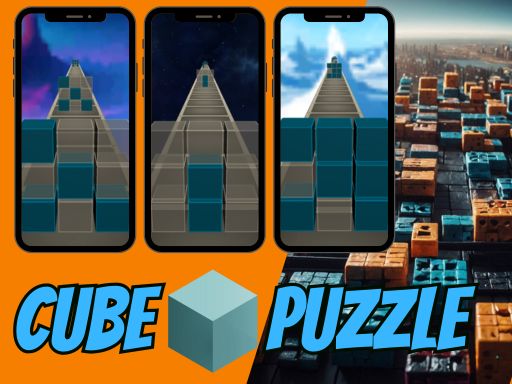Block Number Puzzle
Played 9 times.
How to Play
Game Description
Block Number Puzzle: The Secret to Sharpening Your Mind One Slide at a Time
Remember that satisfying click when puzzle pieces finally snap into place? Block Number Puzzle delivers that same thrill digitally, transforming the classic sliding tile game into a dynamic brain workout. Unlike static crosswords or repetitive match-3 games, this evolving grid puzzle constantly challenges your spatial reasoning and strategic planning with every move.
What Exactly is Block Number Puzzle?
At its core, Block Number Puzzle (often called Block Number Slide) presents players with a grid containing numbered tiles and one empty space. Your mission seems deceptively simple: slide the blocks to arrange them in perfect numerical sequence. But as any seasoned player will tell you, that simplicity quickly unfolds into complex spatial challenges requiring foresight and tactical precision.
The magic happens through the game's fundamental mechanic - shifting adjacent blocks into the vacant space. With each move, you're not just rearranging numbers; you're navigating a three-dimensional mental maze on a two-dimensional grid. The empty square becomes your most valuable asset, a temporary parking spot that enables intricate block maneuvers.
Why Your Brain Loves This Game
Neuroscientists confirm that puzzle games like Block Number Slide create new neural pathways. Here's what happens cognitively when you play:
- Spatial Intelligence Boost: Visualizing multiple move sequences activates your parietal lobe
- Strategic Planning: Every slide requires anticipating 3-5 moves ahead like a chess player
- Pattern Recognition: Your brain learns to identify efficient pathways through repeated play
- Frustration Resilience: Overcoming gridlock teaches creative problem-solving
Unlike fast-paced action games, Block Number Puzzle operates at your pace. There are no timers counting down (unless you want that challenge in advanced modes). This creates a meditative flow state where minutes melt away as you test different sliding combinations.
Mastering the Slide: Pro Techniques
After solving thousands of grids, competitive players develop signature strategies:
The Row Method
Focus on completing the top row first, then the second row, working downward systematically. This prevents chaotic middle-game scenarios where tiles become trapped between completed sections.
Spiral Sequencing
Arrange tiles in a clockwise spiral from the grid's perimeter inward. Particularly effective for larger 5x5 and 6x6 puzzles where edge pieces anchor your solution.
The "Ghost Space" Technique
Advanced players mentally track where the empty square needs to be 5 moves from now, creating temporary pathways for critical tiles. This foresight separates casual players from true puzzle masters.
Why Difficulty Progression Matters
The genius of Block Number Slide lies in its perfectly calibrated challenge curve:
| Grid Size | Move Possibilities | Average Solve Time | Skill Developed |
|---|---|---|---|
| 3x3 (Beginner) | ~100 combinations | 1-3 minutes | Basic sliding mechanics |
| 4x4 (Intermediate) | ~24,000 combinations | 5-15 minutes | Multi-move planning |
| 5x5 (Expert) | Over 15 million combinations | 20+ minutes | Pattern prediction |
This gradual complexity increase creates what game designers call "positive friction" - that perfect balance between frustration and achievement that keeps you clicking "just one more puzzle."
Beyond Numbers: Unexpected Variations
Modern versions of this classic block puzzle incorporate surprising twists:
- Image Tiles: Assemble fragmented photographs where visual cues replace numbers
- Themed Challenges: Holiday editions with shaped tiles (hearts, snowflakes)
- Multiplayer Mode: Race against friends' ghost solutions in real-time
- Obstacle Blocks: Locked tiles that require special moves to unlock
These innovations prevent cognitive plateauing, ensuring your brain encounters novel challenges even after hundreds of puzzles solved.
Why Block Number Slide Dominates Other Puzzle Games
In a world saturated with mobile games, this classic endures because it delivers:
- Accessible Depth: Simple enough for children, deep enough for mathematicians
- Zero Learning Curve: The "slide to move" mechanic is instantly intuitive
- Cognitive ROI: Tangible improvement in logical thinking after regular play
- Stress-Free Engagement: No ads or paywalls disrupting your flow state
As Dr. Elena Rodriguez, cognitive psychologist at Cambridge, notes: "Block Number Puzzle uniquely combines spatial manipulation with numerical sequencing - it's like doing Sudoku and a jigsaw simultaneously. We see measurable working memory improvements in players after just 15 minutes daily for two weeks."
Getting Started: Your First Moves
New to sliding block puzzles? Avoid common beginner pitfalls with these tips:
- Always move tiles toward their destination rather than away
- Position the empty space downstream from your target tile
- Solve corners first - they're the hardest to reposition later
- When stuck, move completed sections as blocks rather than individual tiles
Most importantly: embrace wrong moves. Unlike games with undo buttons, Block Number Slide teaches you to work through complications - a surprisingly valuable life skill!
The Timeless Appeal of Sliding Puzzles
First popularized in the 1880s as the "15 Puzzle", this format has outlived countless gaming fads because it taps into fundamental human cognition. There's profound satisfaction in bringing order from chaos through pure logic. Each completed grid delivers a dopamine rush proportional to the mental effort invested.
In our distracted digital age, Block Number Slide offers something increasingly rare: focused, single-tasking engagement. The grid demands your full attention, creating a brief sanctuary from notifications and multitasking. It's not just a game - it's cognitive therapy disguised as entertainment.
Ready to test your spatial intelligence? One empty square awaits your strategic brilliance. How few moves can you solve it in?


















































